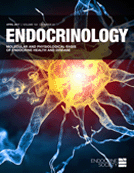-
Views
-
Cite
Cite
SAMUEL REFETOFF, NOEL I. ROBIN, VICTOR S. FANG, Parameters of Thyroid Function in Serum of 16 Selected Vertebrate Species: A Study of PBI, Serum T4, Free T4, and the Pattern of T4 and T3 Binding to Serum Proteins, Endocrinology, Volume 86, Issue 4, 1 April 1970, Pages 793–805, https://doi.org/10.1210/endo-86-4-793
Close - Share Icon Share
Sera from 2-4 adult animals from each of 16 selected vertebrate species [man, rhesus monkey, cattle, sheep, goat, horse, dog, rat, mice (white and brown), guinea pig, rabbit, pigeon, chicken, trout and perch] were examined for total protein, PBI, serum total T4, T4 dialyzable fraction, resin T3 uptake, the maximal T4 binding capacity of T4 binding proteins and the concentration of free T4 calculated. The pattern of T4 and T3 binding to serum proteins was also examined qualitatively by starch gel, paper and agarose gel electrophoreses in 4 different buffer systems. All animals exhibited T4 and T3 binding to one or more serum proteins. Binding of T4 to prealbumin occurred in sera from man, rhesus monkey, horse, pigeon and chicken. T3 bound to the prealbumin zone only in the pigeon. T4 binding to prealbumin was inhibited by 0.075M barbital in all species capable of binding T4 to this protein except for the pigeons. There was no inter- or intraspecies correlation between the total serum protein concentration and the maximal T4 binding capacity to serum proteins, total T4 or free T4. With the exception of the rhesus monkey, serum free T4 concentration in most mammals was within the accepted normal range for human, despite a wide range of variability in the PBI, total T4 and resin T3 uptake. Avians had moderately raised, and fish very high, free T4 levels. The interspecies and to some extent intraspecies constancy of the free T4 concentration despite wide variability in other parameters of thyroid function suggests that this test may, as in the human, more accurately correlate with the peripheral tissue effect of thyroid hormones. (Endocrinology86: 793, 1970)





